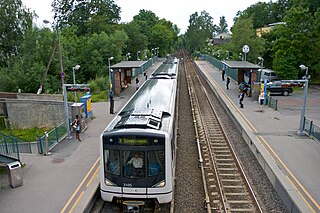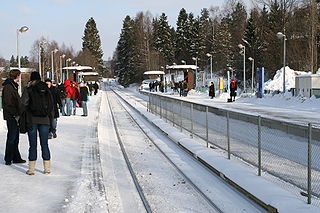Related Research Articles

Sporveien Oslo AS is a municipally owned public transport operator in Oslo, Norway. It operates the trackage and maintains the stock of the Oslo Metro and Oslo Tramway, as well as owning eight operating subsidiaries. In 2005, its 2,365 employees transported 160 million passengers 710 million kilometers, and since 2008 it has operated on contract with the public transport authority Ruter.

The Sognsvann Line is a rapid transit line on the Oslo Metro of Norway. It branches from the Common Tunnel at Majorstuen and runs 6.0 kilometers (3.7 mi) to Sognsvann. After Ullevål stadion, the Ring Line branches off. The Sognsvann Line serves the northwestern and northern neighborhoods of Oslo, mostly within the borough of Nordre Aker. The line is owned and maintained by Kollektivtransportproduksjon and has nine stations. The western end of line 5 serves the entire line. Line 4 and the eastern end of line 5 serve the southern part of the line up to Ullevål stadion before branching off and continuing along the Ring Line. This gives an average five-minute headway on the southern part and an average fifteen-minute headway on the northern part of the line.

Blindern is a rapid transit station on the Oslo Metro's Sognsvann Line. It is situated in the Blindern neighborhood of the Nordre Aker borough of Oslo, Norway. Located 4.0 kilometers (2.5 mi) from Stortinget, the station is served by lines 4 and 5 of the metro, with a combined five-minute headway. Travel time to Stortinget is seven minutes. Along with Forskningsparken, it serves the campus of the University of Oslo.

Ullevål stadion is a rapid transit station of the Oslo Metro's Sognsvann Line. It is situated between the Sogn and Ullevål Hageby neighborhoods of the Oslo, Norway, borough of Nordre Aker. Located 5.3 kilometers (3.3 mi) from Stortinget, the station is served by lines 4 and 5 of the metro, with a combined five-minute headway. Travel time to Stortinget is nine minutes. It is named for and serves Ullevaal Stadion, a football venue home to Vålerenga and the Norway national football team.

Sognsvann is a rapid transit station of the Oslo Metro's Sognsvann Line. It is situated Kringsjå neighborhood of the Oslo, Norway, borough of Nordre Aker. Located 8.7 kilometers (5.4 mi) from Stortinget, the station is served by Line 5 of the metro every fifteen minutes. Travel time to Stortinget is sixteen minutes.

T1000 and T1300 were two rapid transit train classes used on Oslo Metro in Oslo, Norway. The 197 cars were built by Strømmens Verksted, Norsk Elektrisk & Brown Boveri and AEG between 1960 and 1981. They were the first metro trains used in Oslo, and had remained in active use until being replaced by OS MX3000 trains in 2007. Each car is equipped with a driver's cab at one or both ends and four motors, each with 98 kilowatts (131 hp). The cars are 17 meters (56 ft) long, 3.2 meters (10 ft) wide and 3.65 meters (12.0 ft) tall. The trains use 750 V current, and are capable of 70 kilometres per hour (43 mph). Signaling is provided through automatic train protection.
The Royal Norwegian Ministry of Transportation and Communications is a Norwegian ministry established in 1946, and is responsible for transportation and communication infrastructure in Norway. Since January 2020, the ministry is led by Knut Arild Hareide. The department must report to the parliament (Stortinget).

Kringsjå is a rapid transit station of the Oslo Metro's Sognsvann Line. It is situated Kringsjå neighborhood of the Oslo, Norway, borough of Nordre Aker. Located 8.4 kilometers (5.2 mi) from Stortinget, the station is served by Line 5 of the metro every fifteen minutes. Travel time to Stortinget is fifteen minutes.

Berg is a station on the Sognsvann Line of the Oslo Metro in Norway. Located between Ullevål stadion and Tåsen stations, it is the first station after the Ring Line leaves the Sognsvann Line. The station is located 6.1 kilometres (3.8 mi) from Stortinget station. Berg is amongst the original stations on the line, and was opened on 10 October 1934. It was upgraded and rebuilt in the 1990s, when the Sognsvann Line was upgraded from light rail to rapid transit standard. Three accidents have taken place at Berg station, the latest in 2008. The area around the station is mainly residential. Berg Upper Secondary School is located approximately 100 metres (330 ft) from the station.

Tåsen is a station on the Sognsvann Line of the Oslo Metro in Oslo, Norway. The station is located between Berg and Østhorn stations and is 6.8 kilometres (4.2 mi) from Stortinget. As one of the original stations on the line, Tåsen was opened on 10 October 1934. The station was moved 150 metres (490 ft) north in the 1990s, when the line was upgraded from light rail to rapid transit standard. In 1992, a deadly accident occurred when a T1300 train collided with a plowing car ahead of the station.

Bergen Light Rail is a light rail system in Bergen, Norway. The first stage of the project was a twenty-station stretch between the city center and Lagunen Storsenter, where the first 15 stations comprising a 9.8-kilometre (6.1 mi) stretch opened in 2010, and the second was a 3.6-kilometre (2.2 mi) stretch from Nesttun to Lagunen which opened in June 2013. A third stretch from Lagunen to Bergen Airport, Flesland opened in 2017. Further plans for the project involve mooted extensions to Åsane and Storavatnet.
Ruter AS is the public transport authority for Oslo and Akershus counties in Norway. Formally a limited company – 60% of its shares are owned by the Oslo county municipality and 40% by that of Akershus – it is responsible for the administration, funding, and marketing of public transport in the two counties, including buses, the Oslo Metro, Oslo Trams, and ferry services. Ruter also holds agreements with Norwegian State Railways concerning the regulation of fares on local and regional train services operated within the two counties.

Nationaltheatret is an underground metro station and tram stop serving Vika and the city center of Oslo, Norway. It is located on the Common Tunnel of the Oslo Metro and on the Briskeby Line of the Oslo Tramway. Also located at the same place is Nationaltheatret Station of the Drammen Line. The station is served by all six lines of the metro, and lines 13 and 19 of the tramway. In addition, several bus services call at the station. It is named for the National Theatre located nearby.

SL95 is a series of 32 low-floor, articulated trams operated on the Oslo Tramway. The series was built by Ansaldo/Firema, now Hitachi Rail Italy, and delivered between 1999 and 2004. Capacity for the eight-axle, three-section vehicles is 212 passengers, of which 88 can be seated. The name derives from being ordered in 1995. Original plans called for the delivery to be between 1997 and 1998. Delivery took many years due to a magnitude of technical flaws, including high noise levels, freezing during the winter and corrosion. The trams are 33.12 metres (108.7 ft) long, 2.6 metres wide and 3.62 metres (11.9 ft) tall. The aluminum vehicles weigh 64.98 tonnes and have a power output of 840 kilowatts (1,130 hp).
Nils Carl Aspenberg is a Norwegian journalist, historian, author and businessperson. He has written numerous books on rail transport, and is chief executive officer of Baneforlaget.
Timeline of transport in Oslo covers key incidents within transport in Oslo, the capital of Norway.

Oslo Bus Terminal is the main bus station serving Oslo, Norway. Owned by Vaterland AS it is located beside Oslo Central Station and serves local buses to Akershus as well as domestic and international coaches.
The Oslo Package 2 or O2 is a political agreement for financing investments in public transport in Oslo and Akershus, Norway. The program runs from 2001 to 2011, and includes many large and small investments in railways, the Oslo Tramway, the Oslo Metro and infrastructure for buses. Total budget is 15.6 billion kr. The project is a cooperation between the transit authorities Oslo Sporveier and Stor-Oslo Lokaltrafikk, Oslo Municipality and Akershus County Municipality, and the government agencies of the Norwegian National Rail Administration and the Norwegian Public Roads Administration.

The rolling stock of Oslo Metro, Norway has consisted of three classes: T1000/T1300, T2000 and MX3000. The T1000 was built as 162 single cars from 1964 to 1978. From 1979 to 1985, 33 new T1300 trains were built, followed by the conversion of 16 T1000s. Six two-car T2000 units were delivered in 1994. Since 2005, the first 83 three-car MX3000 units have been replacing the older stock, and the last T1000 was retired in 2007. From 2010, only MX3000-trains are in use. The T1000/T1300 and T2000 were built by Strømmens Værksted, with motors from Norsk Elektrisk & Brown Boveri (NEBB) and AEG, respectively, and the MX3000 were built by Siemens.
På Sporet is a quarterly magazine published by the Norwegian Railway Club. The magazine was started in 1969. It is dominated by news and feature articles about domestic trains and rail transport, but also has a limited amount of international news and features.
References
| This transport magazine or journal-related article is a stub. You can help Wikipedia by expanding it. See tips for writing articles about magazines. Further suggestions might be found on the article's talk page. |
| This Norwegian magazine or academic journal-related article is a stub. You can help Wikipedia by expanding it. See tips for writing articles about magazines. Further suggestions might be found on the article's talk page. |